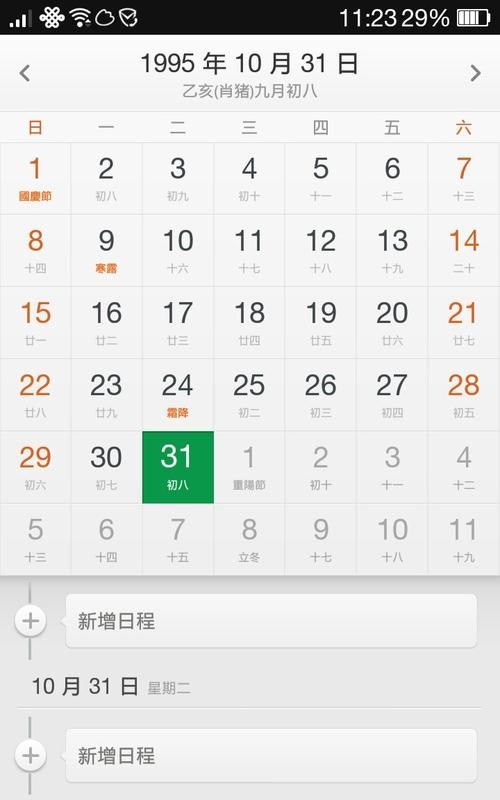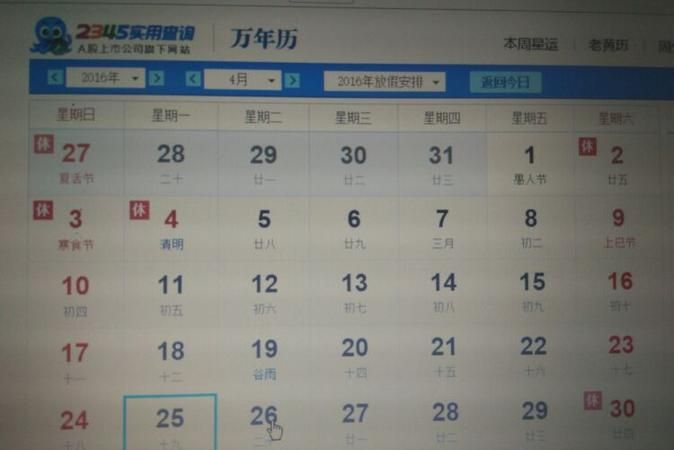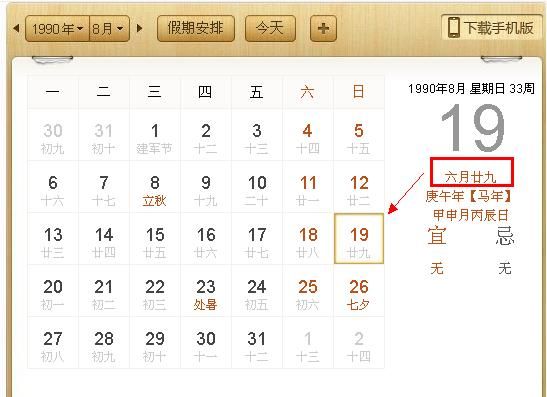Contents of this article
- 1.How many years does the solar calendar and lunar calendar birthdays coincide?
- 2. How many years can a birthday fall on the same day in the lunar calendar and the solar calendar? How many years can a birthday fall on the same day in the lunar calendar and the solar calendar?
- 3. How often does a lunar calendar birthday coincide with a solar calendar birthday?
- 4.How many years does it take for a lunar calendar birthday and a solar calendar birthday to fall on the same day?
How often does the solar calendar and the lunar calendar coincide with birthdays?
Introduction: It is estimated that many people have discovered when they look at their birthdays that sometimes their birthdays coincide with the lunar calendar and the solar calendar. Such a coincidence is quite surprising. Do you know how many years the solar calendar and lunar calendar of birthdays are the same? We will also learn more about whether the solar calendar and the lunar calendar coincide with each other in detail below.
How many years does the solar calendar and lunar calendar have the same birthday?
Generally, every nineteen years or so, there may be one less or more day on the same day in the solar calendar and the lunar calendar, and the birthday in the solar calendar and the lunar calendar will be the same. This situation is mainly due to the leap in the lunar calendar. The lunar calendar coincides with the solar calendar. It has nothing to do with Feng Shui or luck. Therefore, there is nothing good or bad, just treat it normally.
The principle of the 19-year cycle:
365.25*19=29.53*235 (the apparent movement of the sun is 19 years, and the moon has exactly 235 synodic cycles)
However, the Internet has not explained why the horoscopes for the 19th and 38th birthdays are basically the same?
In fact, it is very simple, 365.25*19=6939.75 is approximately 6940 days. As long as it is a multiple of 10 days, the daily stem will be the same as the birthday.
Why is there a coincidence in 2019?
The number of days per month in the lunar calendar is established based on the movement cycle of the moon. In fact, the average number of days per month is 29.5306. If multiplied by 12, there are only 354.3672 days in a year; and the earth revolves around the sun in one cycle (tropical year, tropical year, The solar calendar year) is 365.2422 days, so the actual number of days in a lunar year is 10.875 days less than that of the solar calendar year, almost 11 days, and there are 209 days less in 2019.
209 days divided by 30 is 6.9666. In 19 years, the lunar year is almost 7 months shorter than the solar year. In order to make the lunar calendar and the solar calendar not much different, these 7 months must be made up.
The Chinese lunar calendar is actually a typical lunisolar calendar, a calendar that combines the lunar calendar with the solar calendar. In order to make up for these seven months, people adopt the method of setting leap months in the lunar calendar - seven leap months in nineteen years, that is, on the tenth day of the lunar calendar. Among the nine years, 12 are ordinary years, and each ordinary year has 12 months; plus 7 leap years (the 3rd, 5th, 8th, 11th, 14th, 17th, and 19th years respectively), each leap year has 13 months.
In this way, the number of days in 19 solar calendar years is almost equal to the number of days in 19 lunar calendar years. Therefore, whenever a person is born at the age of 19 or 19 times, there is a chance that the solar calendar birthday and the lunar calendar birthday will appear on the same day.
Regardless of whether it is a lunar month or a solar calendar year, the exact number of days is not an integer but a decimal. There is still a slight difference in the number of days in the 19 years of the lunar calendar and the solar calendar. After decades or even hundreds of years of accumulation, the decimal has also become For large numbers, there is a phenomenon of non-overlapping, but generally the difference is only one day, either earlier or later.
A year is not 365 days
We know that climate changes of warm spring, hot summer, cool autumn, and cold winter are closely related to the life and production of humans, especially people in the temperate zones of the earth. This kind of year consisting of the four seasons of spring, summer, autumn and winter is called a "tropical year." That is, the cycle in which the sun goes from the highest to the lowest, and then from the lowest back to the highest. It is strictly defined in astronomy as: "ordinary year." The time interval between the sun passing through the vernal equinox twice consecutively. "According to the results of long-term astronomical observations, we know that the length of the tropical year is 365.2422 days, which is 365 days, 5 hours, 48 minutes and 46 seconds. This is another very important data when formulating the calendar. , which must be kept in mind, can be roughly recorded as 365 and a quarter days. The data obtained by ancient almanacists did not reach such a level of accuracy all at once, but always gradually became more accurate with the development of the calendar.

How many years can a birthday fall on the same day in the lunar calendar and the solar calendar? How many years can a birthday fall on the same day in the lunar calendar and the solar calendar?
Introduction: How often do we have birthdays on the same day in the lunar calendar and the solar calendar? Most people will find out when they are 19 years old or have a birthday that is a multiple of 19 that their birthday is on the same day in the lunar calendar and the solar calendar. Not everyone can encounter this coincidence, but if you look carefully, you can find that even if it is not The 19-year-olds coincide once, and the dates are not much different. The difference is only one day. Let’s explain the coincidence of how many years in the lunar calendar and solar calendar the birthday can fall on one day!
How many years can a birthday fall on the same day in the lunar calendar and the solar calendar? How many years can a birthday fall on the same day in the lunar calendar and the solar calendar?
Birthdays on the same day in the lunar calendar and the solar calendar can happen about once every 19 years.
We say that the big month in the lunar calendar has 30 days and the small month has 29 days, and a year has 12 months, which is 354 days. But our solar calendar has 365 days, so what should we do? In ancient times, there was a solution, which was to add 7 leap months in 19 years, which is 210 days. The original 19 years had 209 days less, so we say that the lunar calendar coincides with the solar calendar.
So nineteen years is a cycle. As for the difference of one day for some people, it is the day of difference between 210 and 209 here. Of course, this is a general statement.
The leap month in the lunar calendar is to coordinate the contradiction between the return year and the lunar year. First we have to remember: the total length of the tropical year is 365.2422 days, and the length of the synodic month is 29.5306 days. The 12 synodic months are 29.5306×12=354.3672 days, which is 10.88 days less than the tropical year, which is nearly 11 days. Each month is 0.91 days less, which is nearly 1 day.
If the lunar year is composed of thirteen lunar months, the length is 29.5306×13=383.8978 days, which is 18 days longer than the tropical year.
If the calendar is formulated according to the above provisions, there will be a strange phenomenon in which the weather and the calendar are inconsistent, and the time sequence is disordered and reversed - this is a contradiction.
In order to overcome this shortcoming, our ancestors found out the method of "leap month" based on astronomical observations to ensure that the first month to March of the lunar year is spring, April to June is summer, and July to September is Autumn, October to December is winter, which also ensures that the beginning of the lunar year is at the end of winter and the beginning of spring.
The middle month of the lunar year is based on the length of the synodic month of 29.5306 days, so the big month is 30 days and the small month is 29 days. In order to ensure that the first day of each month (the first day of the lunar month) must be the new moon, the arrangement of the big and small months is not fixed and needs to be determined through strict observation and calculation. Therefore, it is common for two consecutive months in the lunar calendar to be the big month or the small month. There have even been four consecutive months, such as March and April in 1990, and four consecutive months on the ninth, tenth, eleventh and twelfth month. It is a rare exception of Otsuki.
How long does it take to add a leap month?
The best way is to find the least common multiple of the number of days in a tropical year and the number of days in a synodic month: We hope that the number of days in m tropical years is equal to the number of days in n synodic months, that is, there should be an equation: m×365.2422=n×29.5306
In this equation we cannot find m and n directly, but we can find their ratio:
Approximate values for this ratio are:
In these fractions, the numerator represents the number of tropical years and the denominator represents the number of synodic months. For example, the sixth fractional expression means that 7 leap months must be added to the 19 tropical years.
Comparison of the results of adding 7 leap months in 19 tropical years:
19 return years = 19 × 365.2422 = 6939.6018 (days)
There are 29.5306 days in a synodic month, 235 synodic months = 235 × 29.5306 = 6939.6910 (days)
After adding 7 leap months to the 19 tropical years, the contradiction is eliminated to only: 6939.6910-6939.6018=0.0892 (days) - that is, more than 2 hours and 9 minutes, which is accurate enough. Therefore, the lunar calendar adopts the method of adding 7 leap months to 19 years, that is, the "seven leap months in nineteen years" method, which coordinates the return year with the lunar year well, so that the New Year's Day (Spring Festival) of the lunar calendar always remains at the end of winter and the beginning of spring. . The ancients called the 235 synodic months "leap weeks".
The method of setting leaps in the lunar calendar can make the average length of the lunar year close to the tropical year, and the months in the lunar calendar have distinctive moon phase characteristics, maintaining the best of both worlds of the Gregorian and lunar calendars.
The current method of setting leaps is between two winter solstices. If there are only 12 months, no leaps will be set. If there are 13 months, leaps will be set. The leap months start from the "winter solstice". When the first month without "Zhongqi" appears, this month is a leap month, and its name is to add the word "leap" in front of the previous month.
our calendar
There are two current calendars in our country: the Gregorian calendar and the lunar calendar. There are three main calendars: solar calendar, lunar calendar and lunisolar calendar. The solar calendar is also the solar calendar, and its calendar year is a tropical year. The currently internationally accepted Gregorian calendar (Gregorian calendar) is a type of solar calendar, also referred to as the solar calendar; the lunar calendar is also called the lunar calendar, or the lunar calendar, and its calendar months It is a synodic month, and there are 12 synodic months in a calendar year. The big month has 30 days and the small month has 29 days. The average calendar year of the lunisolar calendar is a tropical year, and the calendar month is a synodic month. Because the 12 synodic months are too different from the tropical year, leap months are set in the lunisolar calendar. Therefore, this calendar is consistent with the moon phases and the cyclical movement of the earth around the sun. The Chinese lunar calendar is a lunisolar calendar.

How long does it take for a lunar birthday to coincide with a solar birthday?
Introduction: Because we have always used two different calendars, the solar calendar and the lunar calendar, some of our birthdays are celebrated according to the solar calendar, some are celebrated according to the lunar calendar, and some people celebrate both birthdays, but sometimes the lunar and solar calendar birthdays are They will overlap, so how often do birthdays in the lunar calendar and solar calendar coincide? If you want to know how many years the lunar calendar birthday and the solar calendar birthday coincide, please click to view the article below!
How often do birthdays in the lunar calendar and solar calendar coincide? How often do birthdays in the lunar calendar coincide with birthdays in the solar calendar?
Birthdays in the lunar and solar calendars generally coincide with each other every 19 years
This situation occurs mainly because of the leap in the lunar calendar. Why is there a coincidence in 2019? The number of days per month in the lunar calendar is established based on the movement cycle of the moon. In fact, the average number of days per month is 29.5306. If multiplied by 12, there are only 354.3672 days in a year; and the earth revolves around the sun in one cycle (tropical year, tropical year, The solar calendar year) is 365.2422 days, so the actual number of days in a lunar year is 10.875 days less than that of the solar calendar year, almost 11 days, and there are 209 days less in 2019.
209 days divided by 30 is 6.9666. In 19 years, the lunar year is almost 7 months shorter than the solar year. In order to make the lunar calendar and the solar calendar not much different, these 7 months must be made up.
The Chinese lunar calendar is actually a typical lunisolar calendar, a calendar that combines the lunar calendar with the solar calendar. In order to make up for these seven months, people adopt the method of setting leap months in the lunar calendar - seven leap months in nineteen years, that is, on the tenth day of the lunar calendar. Among the nine years, 12 are ordinary years, and each ordinary year has 12 months; plus 7 leap years (the 3rd, 5th, 8th, 11th, 14th, 17th, and 19th years respectively), each leap year has 13 months.
In this way, the number of days in 19 solar calendar years is almost equal to the number of days in 19 lunar calendar years. Therefore, whenever a person is born at the age of 19 or 19 times, there is a chance that the solar calendar birthday and the lunar calendar birthday will appear on the same day.
Regardless of whether it is a lunar month or a solar calendar year, the exact number of days is not an integer but a decimal. There is still a slight difference in the number of days in the 19 years of the lunar calendar and the solar calendar. After decades or even hundreds of years of accumulation, the decimal has also become For large numbers, there is a phenomenon of non-overlapping, but generally the difference is only one day, either earlier or later.
The coincidence of Mid-Autumn Festival and National Day falling on the same day
According to research, this calendar phenomenon of two festivals meeting only occurs once every 19 years. The last time it appeared was in 1982, and 2001, the first year of the new century, encountered such a coincidence again.
Generally speaking, the date of our traditional Mid-Autumn Festival, the fifteenth day of the eighth month of the lunar calendar, is not fixed in the Gregorian calendar. The solar term corresponding to the Mid-Autumn Festival should be the "autumn equinox", so the date of the Mid-Autumn Festival must be within the time range of half a month before and after the "autumn equinox". The "Autumnal Equinox" is basically around September 23rd of the year, so the Mid-Autumn Festival can appear on September 8th at the earliest (such as 1976), and on October 8th (such as 1938) at the latest.
In other words, every day from September 8th to October 8th of the year may be the Mid-Autumn Festival. Calculated in this way, in the leap April of 2001, there were a total of 384 days from the Mid-Autumn Festival in 2000 to the Mid-Autumn Festival in 2001, 19 days more than the Gregorian calendar year. Therefore, the Mid-Autumn Festival in 2001 will be 19 days later than the previous year. The Mid-Autumn Festival in 2000 was on September 12th, so the Mid-Autumn Festival in 2001 also fell on October 1st.
leap month
Leap Month is a calendar method of setting leap months. In Asia (especially in China), the leap month specifically refers to the extra month in the Han calendar (also known as the lunar calendar among the people) in every leap year (in order to coordinate the contradiction between the return year and the Han calendar year and prevent the Han calendar year and month from being out of touch with the return year and the four seasons, every 2 A leap week is set in the third year. In ancient times, a leap week was used to set a leap week in the 19th year. In the "Linder Calendar" of the Tang Dynasty, the fixed leap week was abolished and a leap week was set in the month without a festival. Therefore, a leap week is set in the leap year) .
Which leap month is in the lunar calendar? Determined by the twenty-four solar terms of the year.
The Chinese lunar calendar divides the twenty-four solar terms into twelve solar terms and twelve middle terms.
The dates of the twenty-four solar terms in the lunar calendar are postponed month by month, so in some lunar months, the middle energy falls at the end of the month, and there is no middle energy in the next month.
Generally, every two years or so there is a month without a zhongqi, which coincides with the year when a leap month needs to be added. Therefore, the lunar calendar stipulates that the month without Zhongqi is regarded as a leap month.
For example, in 2001, the 29th day of April in the lunar calendar was a small full period of Zhongqi. The next one was the summer solstice on the first day of the month. If there was no Zhongqi in this month, it was designated as a leap month. It follows April. That’s why it’s called leap April.

How many years does it take for a lunar birthday to fall on the same day as a solar birthday?
There is no standard answer to your question! The "lunar calendar" you mentioned should refer to the lunar calendar! The "Gregorian calendar" you mentioned refers to the Gregorian calendar, right?
This kind of coincidence between the Gregorian calendar date and the lunar calendar date usually occurs once every 19 years or a multiple of 19 years. But there are exceptions. And on different dates in different years, the length of the interval may also be different.
You didn’t say which year or day it was, so I can’t check it for you.

The above is all about how many years does a birthday on the same day in the lunar calendar and the solar calendar repeat, how many years does a birthday in the solar calendar coincide with the lunar calendar, and how many years does it happen, as well as related content about the lunar calendar and the solar calendar. I hope it can help you.
